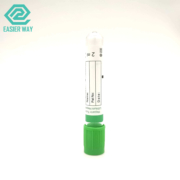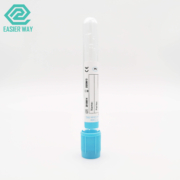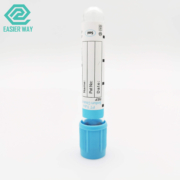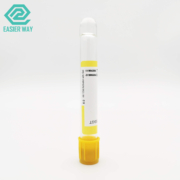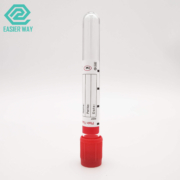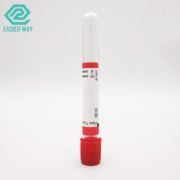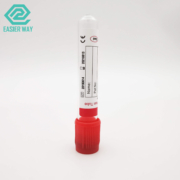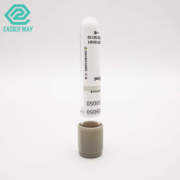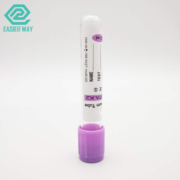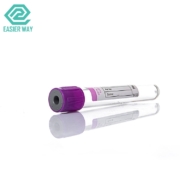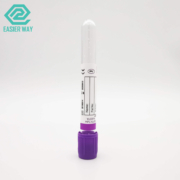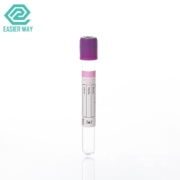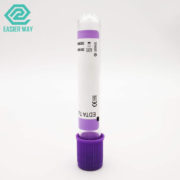Disposable heparin tube for blood collection
Overview
| Model Number: | heparin tube | Brand Name: | OEM,ODM available |
| Disinfecting Type: | Irradiation sterilization | Place of Origin: | Jiangsu, China |
| Properties: | Medical Materials & Accessories | Stock: | Yes |
| Shelf Life: | 2 years | Material: | PET and Glass |
| Quality Certification: | CE , ISO | Instrument classification | Class II |
| Color Cap: | Green | Volume: | 2-10ml |
| Sample: | Availabe | Usage: | Injection & Puncture Instrument |
Product description
Usage:
Vacuum blood collection tube are used together with blood collection needle for blood collecting in clinic and test in lab.
These tubes are applicable to blood serum biochemical, immunization,serum, plasma,blood glucose, whole blood,etc test.
Features:
1) Tube storage temperature range: -38 ~ 90°c
2) Perfect seal between cap and tube
3) Accurate blood drawing volume
4) No hemolysis or protein adsorption
5) Blood clot between 3 minutes for clot activator tube
6) Material: Glass and PET
7) Color of caps: red, orange, yellow, gray, blue, green(heparin blood tube), purple,black
8) Tube normal specification: 13×75mm, 13×95mm, 13×100mm, 16×100mm
9) Blood drawing volume: 1~10ml
10) Package: foaming pallet and carton
11) Max. vacuum degree tolerance:±10%
12) Draw required volume and invert the tube for 6-8 times gently
Application of heparin tube
This less commonly used bottle is for biochemistry tests which require heparinised plasma or whole blood for analysis.
· Additive: Heparin (Sodium/Lithium/Ammonium)
· What additive does: Inhibits thrombin formation to prevent clotting
· Laboratory uses: Chemistry Testing (Plasma determinations in chemistry) : ammonia, carboxyhemoglobin & STAT electrolytes, chromosome screening, insulin, renin and aldosterone
Specification model of blood collection tubes
Application of other blood collection tubes
1. Red
The red bottle is less common – it is used for biochemistry tests requiring serum which might be adversely affected by the separator gel used in the yellow bottle.
· Additive: None or contains silica particles which act as clot activators.
· What additive does: Clot activator promotes blood clotting with glass or silica particles.
· Laboratory Uses: Serum testing (glucose, cholesterol, triglycerides, HDL, potassium, amylase, alkaline phosphatase, BUN, CK, liver enzymes), blood bank, serology (RH Typing, Antibody screening, Red Cell Phototyping, DAT, RPR, monospot, rheumatoid factor, ANA)
2. Yellow
· Additive: anticoagulant SPS (Sodium Polyanetholsulfonate) & ACD (acid citrate dextrose)
· What additive does: Prevents the blood from clotting and stabilizes bacterial growth.
· Laboratory Uses: Blood and bodily fluid cultures (HLA, DNA, Paternity)
Tubes with SPS – For Blood and bodily fluid cultures (HLA, DNA, Paternity). The SPS aids in the recovery of microorganisms by slowing down/ stopping the actions of complement, phagocytes, and certain antibiotics.
Tubes with ACD are for cellular studies, HLA typing, paternity testing.
3. Light Blue
The blue bottle is used for haematology tests involving the clotting system, which require inactivated whole blood for analysis.
· Additive: Sodium Citrate
· What additive does: Binds and remove calcium to prevent blood from clotting
· Laboratory uses: Coagulation (clotting process-P.T)
PT (Prothrombin Time – evaluates the extrinsic system of the coagulation cascade & monitors coumadin therapy)
APTT/ PTT (Activated Partial Thromboplastin Time – evaluates the intrinsic system of the coagulation cascade & monitors heparin therapy)
FDP (Fibrinogen Degradation Products)
TT (Thrombin Time)
Factor assays
4. Lavender
These bottles are generally used for haematology tests where whole blood is required for analysis.
· Additive: EDTA (Ethylenediaminetetraacetic Acid)
· What additive does: Removes calcium preventing clotting of blood
· Laboratory uses: Hematology testing (ESR, CBC w/diff., HgBA1c)
blood film for abnormal cells or malaria parasites, reticulocytes, red cell folate, Monospot test for EBV, parathyroid hormone (PTH)
5. Grey
· Additive: Potassium oxalate and Sodium fluoride
· What additive does: Sodium fluoride acts as an antiglycolytic agent to ensure that no further glucose breakdown occurs within the sample after it is taken. Potassium oxalate removes calcium and acts as an anticoagulant.
· Laboratory uses: Chemistry testing, especially glucose(sugar) and lactate, Glucose tolerance test (GTT)
6. Royal Blue
· Additive: Sodium Heparin also Sodium EDTA
· What additive does: Inhibits Thrombin formation to prevent
· Laboratory uses: Chemistry trace elements (such as Zinc, Copper, Lead and Mercury), toxicology, and nutritional chemistry testing
7. Black
· Additive: Sodium Citrate
· What additive does: Forms calcium salts to remove calcium
· Laboratory uses: pediatric ESR


